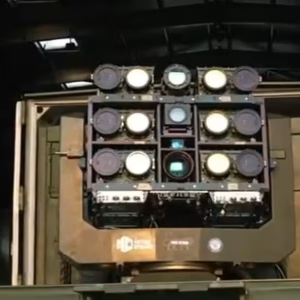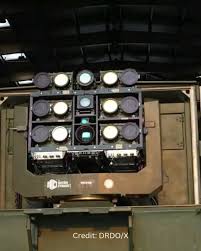New Delhi – In a significant breakthrough for India’s defence technology sector, the country has successfully conducted its first trial of a high-powered India Laser Weapon MK-II(A), using directed energy technology to neutralize an aerial target. The laser-based defense system, indigenously developed by the Defence Research and Development Organisation (DRDO), demonstrated its capacity by effectively shooting down a drone during field trials. This achievement marks a major milestone in India’s journey toward developing futuristic defense capabilities and places the nation among an elite group of countries possessing such advanced technology.

The India Laser Weapon MK-II(A) represents a quantum leap in the country’s defense preparedness, showcasing the nation’s growing technological prowess in an era where aerial threats, particularly drones, are becoming increasingly prominent in modern warfare. The successful trial demonstrates India’s commitment to developing indigenous defense solutions that address contemporary security challenges.
Advanced Tracking and Neutralization Capabilities

The India Laser Weapon MK-II(A) system demonstrated remarkable precision during the trial, with its sophisticated tracking mechanism successfully identifying and locking onto a drone in mid-flight. Once locked, the system deployed a high-energy laser beam that effectively destroyed the target, showcasing both the accuracy and destructive capability of this directed energy weapon.
What makes the India Laser Weapon MK-II(A) particularly noteworthy is its ability to deliver instant impact at the speed of light, unlike traditional weapons that rely on projectiles with travel time. This characteristic makes it exceptionally effective against fast-moving aerial threats like drones and potentially missiles, which can otherwise be difficult to counter with conventional defense systems.
Indigenous Development and Collaborative Effort
The India Laser Weapon MK-II(A) stands as a testament to India’s growing self-reliance in defense technology. Designed and developed entirely within the country, this Directed Energy Weapon (DEW) represents a significant breakthrough for the Indian armed forces.
The development of the India Laser Weapon MK-II(A) was spearheaded by DRDO’s Centre for High Energy Systems and Sciences (CHESS) based in Hyderabad. However, the project benefited from extensive collaborative efforts involving multiple DRDO laboratories, including:
- Laboratory for Radar Development and Electronics (LRDE)
- Instruments Research and Development Establishment (IRDE)
- Defence Electronics Research Laboratory (DLRL)
Beyond DRDO facilities, the development process also incorporated expertise from Indian academic institutions and private industry partners, highlighting the comprehensive ecosystem that contributed to this technological achievement. This collaborative approach underscores India’s strategy of leveraging diverse knowledge bases to accelerate technological innovation in the defense sector.
Successful Field Demonstration at Kurnool


The landmark trial of the India Laser Weapon MK-II(A) was conducted at the National Open Air Range in Kurnool, Andhra Pradesh. This location provided the ideal testing environment for evaluating the system’s performance under real-world conditions.
Following the successful demonstration, DRDO shared the achievement on social media platform X (formerly Twitter), stating: “CHESS DRDO conducted a successful field demonstration of the Land version of Vehicle mounted Laser Directed Weapon(DEW) MK-II(A) at Kurnool today. It defeated the fixed wing UAV and Swarm Drones successfully causing structural damage and disabled the surveillance sensors. With this successful trial, the country has joined the exclusive club of the Global powers who possess the high power Laser DEW System.”
The field demonstration showcased the versatility of the India Laser Weapon MK-II(A) by highlighting its effectiveness against multiple types of aerial threats. The system successfully engaged with fixed-wing unmanned aerial vehicles (UAVs) and coordinated drone swarms, demonstrating its adaptability to various threat scenarios. This multi-target capability represents a crucial advantage in modern warfare, where adversaries might deploy different types of aerial platforms simultaneously.
Operational Mechanism of the India Laser Weapon MK-II(A)
The India Laser Weapon MK-II(A) functions through an integrated system of detection, tracking, targeting, and neutralization. When an aerial threat is detected by the system’s radar or electro-optic (EO) sensors, the India Laser Weapon MK-II(A) can swiftly lock onto the target and deliver a high-intensity laser beam.
This laser beam travels at the speed of light, allowing for near-instantaneous engagement with the target. When the beam makes contact with the drone or UAV, it causes structural failure by rapidly heating the target’s components beyond their tolerance levels. In cases where the beam strikes explosive components or fuel tanks, more catastrophic results can occur, leading to the complete destruction of the threat.
During the Kurnool field test, the India Laser Weapon MK-II(A) demonstrated its capabilities by engaging with long-range fixed-wing drones, disrupting coordinated drone attacks, and specifically targeting and disabling enemy surveillance devices such as sensors and antennae. This precision targeting capability is particularly valuable as it allows for the neutralization of specific components without necessarily destroying the entire platform, which could be useful in scenarios where capturing intelligence is preferable to complete destruction.
The India Laser Weapon MK-II(A) delivers a combination of precision, speed, and lethality that makes it one of the most effective counter-drone systems developed so far. Its ability to engage targets within seconds provides a significant tactical advantage against rapidly emerging threats, potentially closing the gap between threat detection and neutralization that exists with conventional weapons systems.
Advantages of Directed Energy Weapons
The successful demonstration of the India Laser Weapon MK-II(A) highlights the numerous advantages that directed energy weapons offer over traditional defense systems. These advantages are particularly relevant in the context of emerging threats like drone swarms, which present unique challenges to conventional air defense systems.
Cost-Effectiveness in Prolonged Engagements
One of the most significant advantages of the India Laser Weapon MK-II(A) and similar directed energy weapons is their reduced dependence on costly ammunition. Traditional air defense systems rely on interceptor missiles or projectiles that can cost thousands or even millions of dollars per unit. In contrast, the India Laser Weapon MK-II(A) primarily requires electrical power to operate, with the cost per engagement being significantly lower once the system is deployed.
This cost advantage becomes especially pronounced when dealing with threats like drone swarms, where multiple targets must be engaged in rapid succession. While intercepting dozens of drones with conventional missiles would be prohibitively expensive, the India Laser Weapon MK-II(A) can engage multiple targets sequentially with minimal additional cost beyond the initial system investment and operational power requirements.
Minimal Collateral Damage
The precision of the India Laser Weapon MK-II(A) allows for highly targeted engagements that minimize collateral damage. Unlike explosive projectiles that can affect a wide area, the laser beam can be precisely focused on specific components of the target. This precision is particularly valuable in urban environments or situations where civilian infrastructure might be nearby.
Furthermore, the absence of explosive ordnance means there is no risk of unexploded munitions causing harm after an engagement. This characteristic makes the India Laser Weapon MK-II(A) suitable for use in a wider range of operational scenarios, including those with stringent rules of engagement regarding collateral damage.
Speed of Engagement
With the India Laser Weapon MK-II(A), there is virtually no delay between target acquisition and engagement, as the laser beam travels at the speed of light. This immediate response capability is crucial when dealing with fast-moving targets or those that appear with little warning, such as drones launched from nearby positions.
The speed advantage also extends to sequential engagements, where multiple threats must be neutralized in rapid succession. While conventional systems might require reloading or have rate-of-fire limitations, the India Laser Weapon MK-II(A) can transition between targets almost instantaneously, limited only by its targeting system’s capabilities and power management considerations.
Counter to Low-Cost Threats
The emergence of relatively inexpensive yet potentially damaging threats like commercial drones retrofitted for military purposes has created an asymmetric challenge for defense forces worldwide. Using multi-million-dollar interceptor missiles against thousand-dollar drones represents an unsustainable cost imbalance. The India Laser Weapon MK-II(A) helps address this imbalance by providing a cost-effective counter to these low-cost threats.
This capability is particularly relevant in the context of current global conflicts, such as the war in Ukraine, where improvised drone attacks have become a common tactic. The India Laser Weapon MK-II(A) provides India with a viable defense against similar threats, ensuring that potential adversaries cannot exploit economic asymmetries in warfare.
India Joins Elite Global Club of Laser Weapon Developers
With the successful demonstration of the India Laser Weapon MK-II(A), India has joined a select group of nations that possess high-powered laser directed energy weapon systems. According to DRDO Chairman Samir V Kamat, this places India among a very limited number of countries with this advanced capability.
Also Read: Tahawwur Rana Makes 3 Aggressive Demands in NIA Custody
“As far as I know, it is the United States, Russia and China that have demonstrated this capability. Israel is also working on similar capabilities, I would say we are the fourth or fifth country in the world to demonstrate this system,” Dr. Kamat told news agency ANI.
This achievement represents a significant leap in India’s defense technological capabilities, positioning the country at the forefront of military innovation globally. The development of the India Laser Weapon MK-II(A) not only enhances India’s defense preparedness but also strengthens its position as a technological leader in the international arena.
The India Laser Weapon MK-II(A) program exemplifies the country’s growing self-reliance in critical defense technologies, reducing dependence on foreign suppliers for advanced weapon systems. This self-sufficiency is aligned with India’s broader strategic objectives of enhancing indigenous defense manufacturing capabilities and reducing vulnerability to external supply chain disruptions or geopolitical pressures.
Future Prospects: The Dawn of ‘Star Wars’ Technology in India
According to DRDO Chairman Dr. Samir V Kamat, the successful demonstration of the India Laser Weapon MK-II(A) represents just the beginning of India’s journey into advanced directed energy weapons. The DRDO is actively developing a comprehensive suite of high-energy weapons that will significantly enhance India’s defense capabilities in the coming years.
“This is just the beginning of the journey… We are also working on other high energy systems like high energy microwaves, electromagnetic pulse. So we are working on a number of technologies that will give us Star Wars capability. What you saw today was one of the components of Star Wars technologies,” Dr. Kamat explained.
The reference to “Star Wars” technologies alludes to the advanced directed energy and space-based weapon systems conceptualized under the United States’ Strategic Defense Initiative during the 1980s. By developing capabilities like the India Laser Weapon MK-II(A), India is positioning itself at the forefront of next-generation defense technologies that were once considered futuristic.
The roadmap for future development includes several key directed energy technologies:
High-Energy Microwave Systems
Complementing the India Laser Weapon MK-II(A), high-energy microwave systems represent another category of directed energy weapons that DRDO is developing. These systems use intense bursts of microwave energy to disable electronic systems, potentially rendering enemy communication, radar, and computer systems inoperable without causing physical destruction.
Such capabilities would be particularly valuable in modern warfare scenarios where electronic systems play a central role in command, control, and communication functions. The ability to neutralize these systems without physical destruction could provide significant tactical advantages while potentially reducing casualties and collateral damage.
Electromagnetic Pulse Weapons
DRDO’s work on electromagnetic pulse (EMP) weapons represents another avenue of directed energy weapon development. EMP weapons generate powerful electromagnetic fields that can disrupt or damage electronic equipment across a wide area. These systems could potentially neutralize multiple threats simultaneously or disable enemy command and control infrastructure over a broader region.
The development of EMP capabilities alongside the India Laser Weapon MK-II(A) would provide India’s armed forces with a diverse toolkit of directed energy options, allowing for tailored responses to different threat scenarios based on operational requirements and strategic objectives.
Integration with Existing Defense Systems
Future iterations of the India Laser Weapon MK-II(A) and related directed energy weapons are likely to be integrated with existing air defense networks and command structures. This integration would allow for coordinated responses that leverage both conventional and directed energy weapons, creating a layered defense system capable of addressing a wide spectrum of aerial threats.
For example, the India Laser Weapon MK-II(A) could be deployed alongside conventional air defense systems, with traditional interceptors handling larger threats while the laser system engages smaller targets like drones or addresses threats that penetrate initial defensive layers.
Strategic Implications for India’s Defense Posture
The successful development and demonstration of the India Laser Weapon MK-II(A) has significant implications for India’s overall defense posture and strategic calculus. As the country continues to modernize its armed forces, directed energy weapons like the India Laser Weapon MK-II(A) represent a critical capability enhancement that addresses several contemporary security challenges.
Countering the Drone Threat
The proliferation of drone technology has created new security challenges for nations worldwide. From surveillance to direct attacks, drones represent a versatile threat that can be deployed by both state and non-state actors. The India Laser Weapon MK-II(A) provides India with a credible counter to this emerging threat, enhancing the country’s ability to protect critical infrastructure, military installations, and population centers from drone-based attacks.
This capability is particularly relevant given India’s security environment, where neighboring countries and non-state actors have demonstrated increasing interest in drone technology for military applications. By developing the India Laser Weapon MK-II(A), India has acquired a technological edge in addressing this specific threat vector.
Cost-Effective Air Defense
The economics of air defense have become increasingly challenging as potential adversaries deploy greater numbers of aerial platforms at lower individual costs. The India Laser Weapon MK-II(A) helps address this challenge by providing a cost-effective means of engaging multiple targets without depleting expensive missile inventories.
This economic consideration is particularly important for India, which must maintain defense capabilities across extensive borders while managing resource constraints. The India Laser Weapon MK-II(A) offers a potential solution that balances effectiveness with economic efficiency, allowing for sustainable air defense operations even in scenarios involving numerous incoming threats.
Technological Sovereignty
Beyond the immediate military applications, the development of the India Laser Weapon MK-II(A) reflects India’s growing technological sovereignty in critical defense sectors. By mastering directed energy weapon technology internally, India reduces its vulnerability to technology denial regimes and external supply constraints that might otherwise limit its defense capabilities.
This technological independence aligns with broader national objectives of self-reliance in strategic sectors and enhances India’s position as a developer rather than merely a consumer of advanced defense technologies. The expertise gained through the India Laser Weapon MK-II(A) program will likely have spillover benefits for other defense and civilian technology initiatives.
Comparative Context: Global Directed Energy Weapon Programs
The successful demonstration of the India Laser Weapon MK-II(A) places India in the company of a select few nations with operational directed energy weapon capabilities. Understanding the global context helps assess the significance of India’s achievement.
United States
The United States has been at the forefront of directed energy weapon development, with programs like the Navy’s Laser Weapon System (LaWS) and the Army’s High Energy Laser Mobile Demonstrator (HEL MD). The US has deployed laser systems on naval vessels and continues to expand its directed energy capabilities across different military branches.
Compared to these systems, the India Laser Weapon MK-II(A) appears to offer similar core functionality while being developed with significantly fewer resources. This efficiency in development underscores the effectiveness of India’s approach to defense innovation.
Russia
Russia has reportedly developed several directed energy weapon systems, including the Peresvet laser system, which entered service with the Russian military in 2018. Russian officials have claimed that these systems can counter satellite reconnaissance and disable enemy equipment.
The India Laser Weapon MK-II(A) represents India’s entry into this exclusive technological domain, potentially providing capabilities comparable to those developed by Russia but with indigenous technology and control.
China
China has invested heavily in directed energy weapons, with multiple laser and microwave systems reportedly in development or early deployment. Chinese military writings have emphasized the importance of directed energy weapons in future warfare, particularly for anti-satellite and anti-drone applications.
By successfully developing the India Laser Weapon MK-II(A), India has established technological parity in a key area where China has been seeking advantages, potentially neutralizing strategic imbalances in the region.
Israel
Israel has been developing directed energy weapon systems, particularly for counter-drone and rocket defense applications. The “Iron Beam” system represents Israel’s major initiative in this area, designed to complement existing missile defense systems like Iron Dome.
The India Laser Weapon MK-II(A) shares similar operational objectives with Israel’s systems, focusing on cost-effective engagement of multiple threats, though it appears to have been developed through a more self-reliant approach without significant external technological assistance.
Final Word: A New Chapter in India’s Defense Technology
The successful trial of the India Laser Weapon MK-II(A) marks a significant milestone in India’s defense technology journey. By joining the elite club of nations with operational directed energy weapons, India has demonstrated its growing technological prowess and commitment to developing advanced indigenous defense capabilities.
The India Laser Weapon MK-II(A) addresses several contemporary security challenges, particularly the emerging threat of drone warfare, while offering economic and operational advantages over conventional defense systems. Its precision, speed, and cost-effectiveness make it an invaluable addition to India’s defensive arsenal.
As DRDO continues to develop additional directed energy technologies, including high-energy microwaves and electromagnetic pulse systems, India is poised to expand its capabilities in this critical domain further. The reference to “Star Wars” technologies by DRDO Chairman Dr. Kamat suggests an ambitious roadmap that could position India at the cutting edge of defense innovation globally.
The India Laser Weapon MK-II(A) represents not just a new weapon system but a testament to India’s growing self-reliance in critical defense technologies. This achievement strengthens India’s strategic position, enhances its defense preparedness, and establishes the country as a developer of advanced military technologies rather than merely a consumer.
As global security challenges continue to evolve, technologies like the India Laser Weapon MK-II(A) will likely play an increasingly central role in national defense strategies. With its successful demonstration of this capability, India has ensured its place at the forefront of this technological revolution, securing both its defensive capabilities and its position as an emerging technology power on the global stage.

